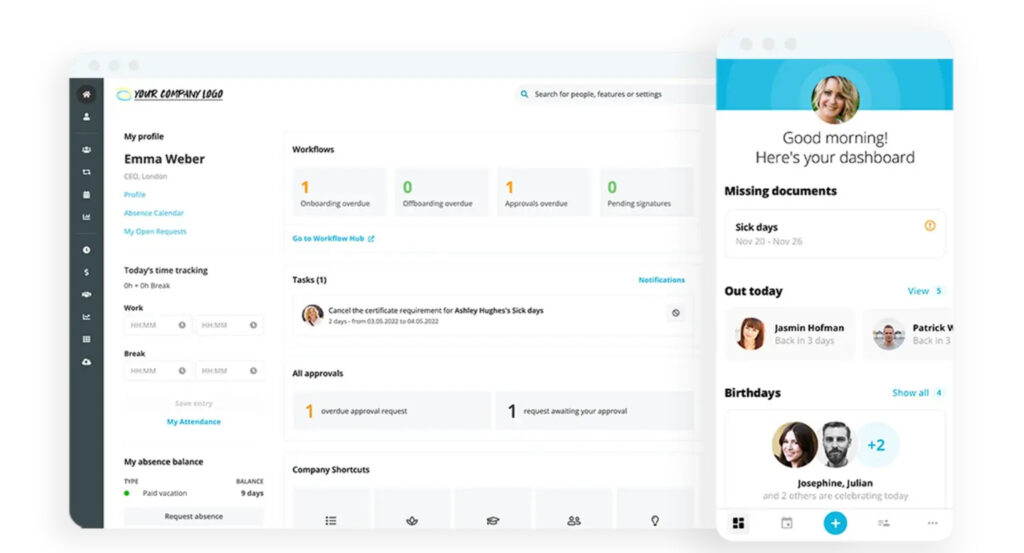Streamlined HR management through EOR and HRIS

Use Personio as a cockpit for your HR processes and create an efficient synergy between EOR and HR administration.


Use Personio as a cockpit for your HR processes and create an efficient synergy between EOR and HR administration.
Onboarding is a crucial process for companies to successfully integrate new employees and to increase their productivity. Employer of Record (EOR) platforms and Human Resource Information System (HRIS) software are playing an increasingly important role in simplifying the onboarding process, making HR management more efficient and providing a satisfactory employee experience from the outset. In collaboration with the experts at Personio—a major HRIS provider in the European market—we provide an in-depth look at how an EOR and HRIS software can make onboarding and HR management a breeze.
An HRIS is a software solution that helps organisations manage human resources more efficiently. It offers features such as electronic employee records, time and attendance systems, performance management and training administration.
Automation and digitalisation: an HRIS enables the automation and digitalisation of processes, which saves time and reduces errors.
Central data storage: Through an HRIS, all stakeholders involved have access to relevant information, which improves communication and collaboration.
Improved employee experience: An HRIS facilitates access to training materials and information on company policies, which promotes the integration of new employees.
An EOR provider supports companies in the formal employment of employees by assuming the role of the legal employer as a third-party provider. In doing so, legal, administrative and tax tasks related to employment are taken over by the EOR. This allows the company to focus on its core competencies and save resources.
Find out more about the recruitment and onboarding process using an EOR.
Linking an EOR platform to an HRIS eliminates the data irregularities. Important personal and employment data is synchronised between the two systems and can be used directly for the onboarding of new employees.
This is a huge time-saver for HR departments, as they do not have to maintain personnel files and data in multiple places, and can focus entirely on creating an appreciative onboarding experience.
The advantages of the integration between the EOR platform and HRIS in connection with the onboarding of new employees:
Time and resource savings: By outsourcing administrative tasks to the EOR, the company saves time and resources.
Compliance with local regulations: The EOR takes responsibility for compliance with local tax regulations and labour laws, minimising legal risks for the company.
Focus on strategic aspects: By outsourcing administrative tasks, the company can focus more on strategic aspects of HR management.
Transparent reporting and analysis: An HRIS system provides powerful analysis and reporting capabilities. By linking EOR services to an HRIS, companies can make informed decisions based on real-time data and track key HR metrics.
Better data integrity: By integrating EOR services with an HRIS system, data is seamlessly synchronised between the two platforms. This improves data integrity and avoids duplication or inconsistent information.
The combination of EOR services and HRIS software provides organisations with a comprehensive solution for human resources management and the onboarding process. This combination enables efficient use of resources, reduces errors and improves the employee experience.
Another important aspect is that communication between HR and new talent during onboarding can be significantly improved.
A holistic HR software setup ensures seamless onboarding processes. HR sets up workflows with specific tasks per position or department so that everything is ready for the new team members on day one – hardware, workplace and important information about company culture.
Thanks to the integrated solution between an HRIS like Personio’s and an EOR platform like WorkMotion’s, all newcomers, regardless of whether they are employed directly on site at the company or abroad, can see all onboarding tasks directly in the tool via an EOR and can process them promptly, e.g. enter all outstanding data into the digital HRIS system or make appointments with colleagues to get to know each other.
If questions do arise, employees can easily contact the HR department via everyday tools such as Slack or Teams. These are linked to an HRIS such as Personio, so that all enquiries end up centrally in the “Employee enquiries” area and are processed here by HR or a chatbot. Employees receive the answers in the same tool they used for the request.
An HRIS is the basic prerequisite for automation in HR. It is the central cockpit of HR departments where all employee data, documents and processes converge. This forms the perfect basis for automations that represent a kind of autopilot for HR.
The onboarding looks like this: A talent is hired remotely in another country via an EOR and signs the contract. When the contract is uploaded, HR initiates a workflow that triggers all onboarding tasks for this candidate at the desired time.
By automating the data entry for the essential data fields, HR managers can focus more on other important tasks and thus create increased added value for their company.
When implementing an HRIS system for EOR talent onboarding, there can be challenges related to data integration, compliance as well as data protection that should not be ignored:
Data integration: The integration of HRIS with EOR systems requires seamless data exchange between the two platforms. Problems can arise when synchronising employee data, such as personal information, employment history and compensation details. How can this be resolved? Ask your HRIS provider for a data export of the required personnel files. This file should be easy to upload in the EOR tool, so that you can access important employee data with just a few clicks. The data fields in both systems must be correctly matched. It is also helpful to develop an automated data transfer mechanism, such as APIs, to reduce manual effort and minimise errors.
Compliance and legal considerations: Onboarding requires compliance with various legal and regulatory requirements, such as tax regulations, labour laws and worker classification rules. When hiring abroad, the EOR provider takes over the administrative tasks of onboarding and ensures compliance with legal requirements. However, it is important to ensure that the HRIS includes the necessary compliance functions such as the creation of the required forms and documents, tracking employment eligibility verification and compliance with data protection regulations. Review and update the HRIS regularly to meet changing compliance requirements.
Data security and privacy: Onboarding involves handling sensitive personal data, so data security and privacy are a top priority. Ensure that both the HRIS and EOR systems have robust security measures in place, including data encryption, access controls and regular security audits. Implementing best practices for handling, storing and transferring data is important here. Comply with relevant data protection regulations such as GDPR or CCPA and establish regular data breach response and incident management protocols.
When selecting EOR and HRIS providers, it is important to consider individual requirements and budgets. Reliability and a good reputation in the industry are also important criteria in the decision-making process.
A good provider must be able to demonstrate that they can work in and with the system in a DSGVO-compliant way, e.g. data should only be allowed to be transferred in encrypted form.
Finally, the use of EOR services and HRIS software offers companies a modern and efficient solution for HR management and the onboarding process. By outsourcing administrative tasks and using digital tools, companies can save time and resources and ensure that new employees have a smooth start. Streamlined HR management is critical to a company’s success, and EOR and HRIS providers like WorkMotion and Personio offer the right tools to meet the challenge.


